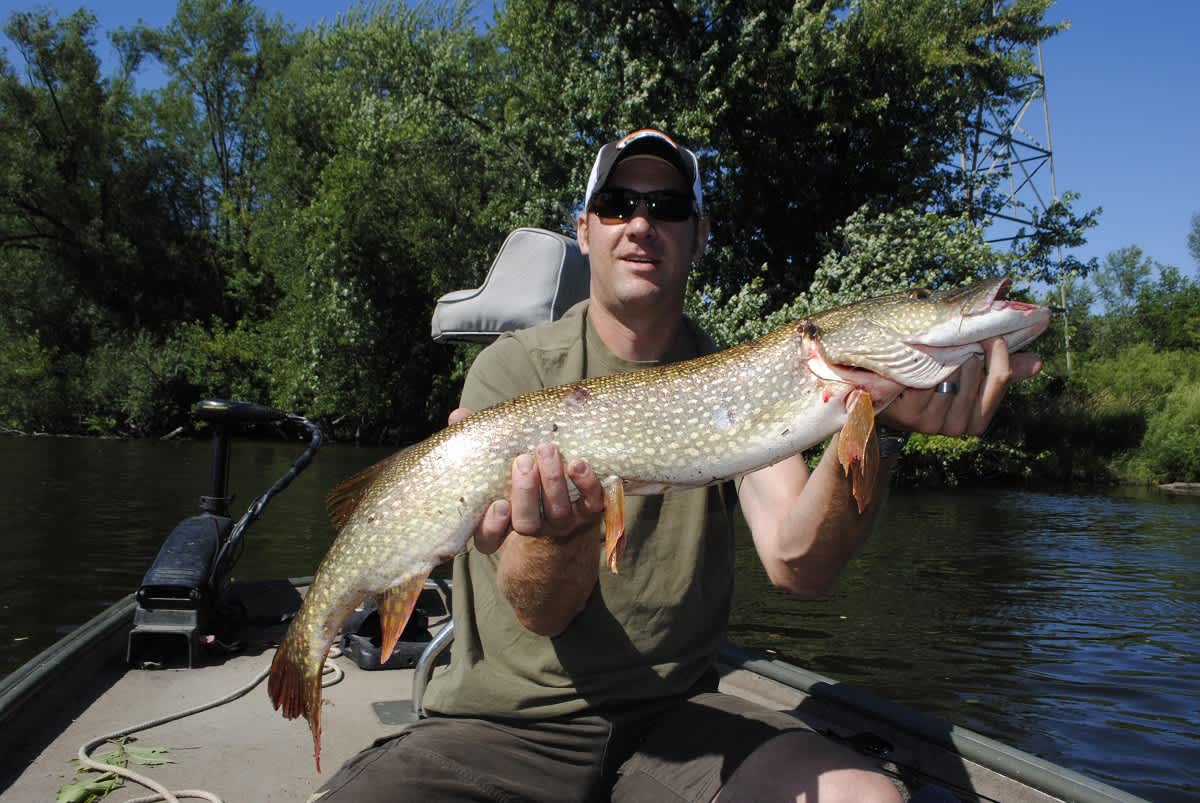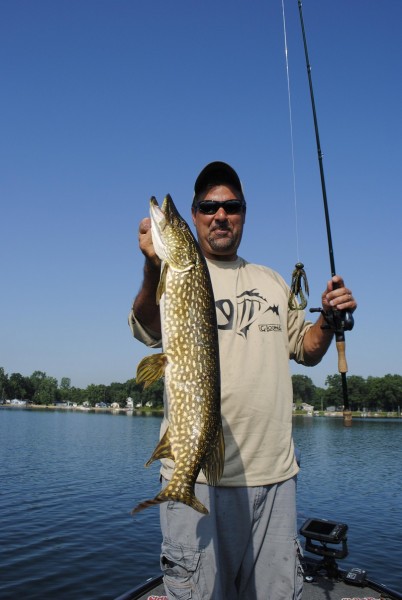Michigan’s Summertime Pike Fishing Can’t Be Beat
Bob Gwizdz 08.10.15

There used to be a common belief among pike anglers that the critters “lose their teeth” in the summer.
There’s no doubt that pike are a little harder to come by during the dog days. But it isn’t because they stop eating. Truth is, pike head deep in the summer in search of cooler water. They are no longer in the shallow weed beds where anglers can find them three other seasons of the year.
But anglers who understand where to find pike (on deep contour lines or on the outside of the deepest weed beds) can continue to take pike when the heat is on. And they’ll be glad they did.
“Pike are so under-rated, they provide a mix of action and quality that I don’t think you find with any other fish,” says Joe Bednar, a Battle Creek-area angler who is probably ol’ toothy’s biggest fan in Michigan. “They’re just awesome.”
Bednar uses two different approaches to catch pike. In lakes, Bednar trolls with crankbaits along deep-water structure. But in rivers, he’s your typical cast-and-retrieve pike angler. Both techniques pay dividends.
“Pike are vulnerable in the mid-summer because they’re at the thermocline and they’re squeezed into a small area,” Bednar said “There’s a fairly tight band of water they’re compressed into—15 to 22 feet—in most lakes, though there are some exceptions. If you can troll accurately, I don’t know that there’s a more effective pike pattern any time of year as the way it sets up in summer.
“You’re looking for a crankbait that runs from about 12 feet (because pike will come up to take them) down to about 16 feet. And there’s a wide variety of crankbaits that get down there.”
Bednar says he trolls around 2.5 miles an hour, which is slower than musky trolling, but faster than walleye trolling. And he holds his rod, instead of putting it in a rod holder, so he can manipulate it, sweeping it forward and speeding it up a bit from time to time, to trigger strikes. Similarly, he makes a lot of turns while trolling so the bait rises and fall in the water column.
“It’s a different ball game than the way most people troll, which is rather passive. I look at it like a never-ending cast. If you work it, like you should, it’s a better approach than what most people perceive trolling to be: just dragging the bait.”
When fishing in smaller rivers, getting deep is not as important because “deep” is relative, Bednar said.
“In a lot of stretches of river, deep water can be three feet,” he said. “I like fishing outside bends in the river where there are holes and the water’s a little slower. Most outside bends have logs and trees down there so you have the cover in there you need.
“Casting accuracy is important,” he continued. “If you’re just slinging it carelessly, you’re going to be in the trees or the weeds or hanging up on rocks. It’s important to get that cast in the right place—like where a tree’s fallen in the water and you get that bait right next to it and bring it back along the trunk. That’s where the fish are sitting.”
Bednar uses three baits when he’s pike fishing in rivers: spinnerbaits, in-line spinners, and floating/diving minnows.

“I like spinnerbaits because they’re a little more forgiving with cover than other baits,” he said. “But I also like a Rapala or any type of minnow bait. You can cast it upriver of the cover and let it float back where you want the bait to be before you retrieve it. That sometimes works better than casting into limbs.”
In-line spinners, he said, promote “an aggressive strike response,” he said. “I’ve gone to a single hook on my spinners because I won’t have the treble hook hanging up on the cover. If you manipulate the hook, you can get it to where it rides up in the water and that makes it more snag-resistant.”
Usually by mid to late August, there’s a cooling trend that gets the pike moving back toward the shallower weed beds. That’s when the bite really commences—simply because it’s easier to find the pike then when they’re deep. In the northern stretches of Michigan, that cooling trend is practically the beginning of fall.
“If you want big fish, August is the best time because they’re beefing up for the winter,” said Don Scott, an Upper Peninsula resort owner who guides pike anglers on Portage Lake in the Keweenaw Peninsula. “In August, you may only catch 10 or 15 fish a day, but you’ll usually get some up in that 30- to 40-inch range.”
By fall, the pike are back at home in the shallower weed beds where they’ll pretty much stay until next summer—and that’s when they’re really vulnerable to anglers. Because there are so many other great recreational opportunities in fall, anglers can have the pike fishing on many of Michigan’s better lakes practically to themselves.
For more information on Michigan fishing go to michigan.org. Click here to purchase a Michigan fishing license online.
This article was produced in partnership with Pure Michigan.

